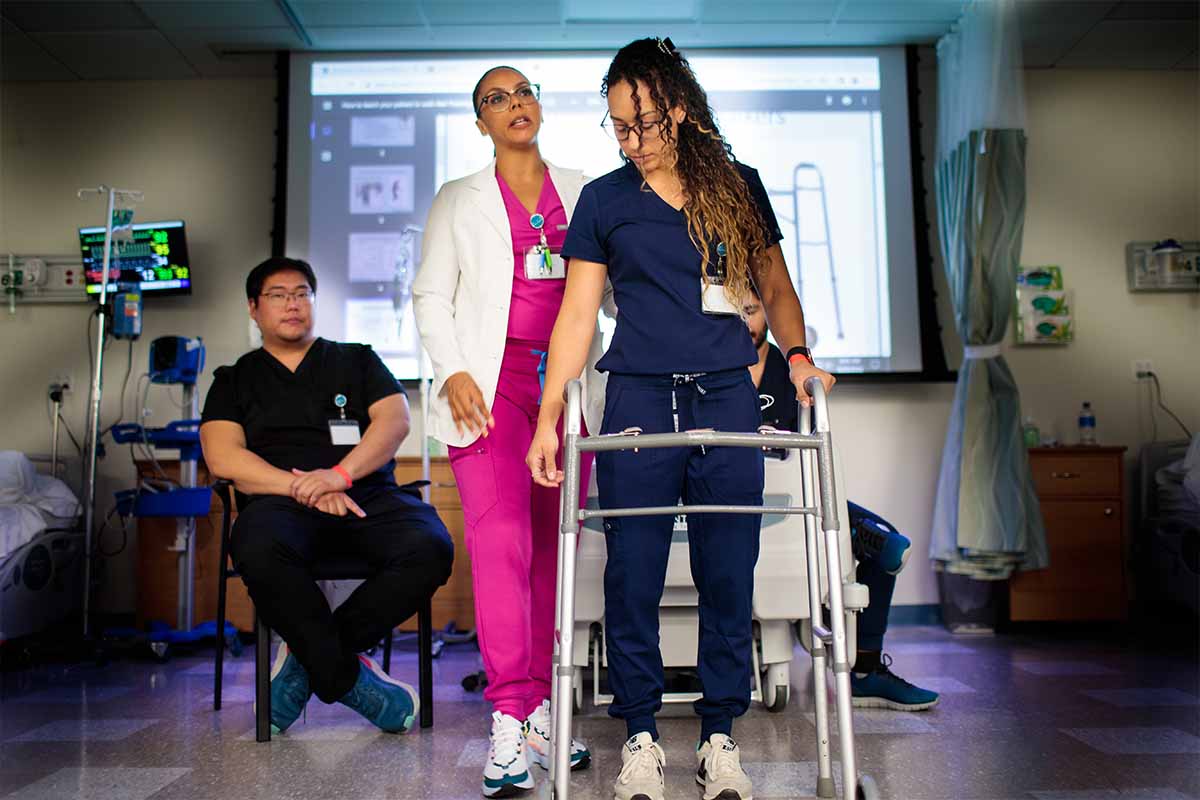
Physical therapy (PT) and occupational therapy (OT) are rehabilitative disciplines that require hands-on work—leading many people to believe they are interchangeable. However, these professions vary greatly.
Which healthcare career is right for you? Consider the differences between occupational therapy vs physical therapy that set these two roles apart.
Occupational Therapy vs Physical Therapy: How do they differ?
The Main Difference
The main difference between OT vs PT: Occupational therapy is used to help patients regain the ability to perform everyday activities on their own, while physical therapy is used to help patients improve their movement and manage their pain.
While both professions support individuals who are recovering from injuries, occupational therapists also assist patients who have cognitive or developmental disabilities that affect their motor skills, behavior or emotions. For example, if patients need help getting dressed or taking a shower, they may benefit from occupational therapy. For post-birth recovery or to improve movement in a sprained ankle, an individual would go to physical therapy.
OT vs PT Distinctions
The differences between physical therapy vs occupational therapy extend beyond job descriptions.
Occupational Therapy vs Physical Therapy: Job Functions
So, what does an OT do? There is some overlap in the skill sets of physical and occupational therapists. Several physical therapy techniques are employed in occupational therapy and vice versa. Physical therapists work primarily with people recovering from musculoskeletal injuries, and use exercise, massage and other techniques to restore function, prevent disability and reduce pain in patients.¹ Their responsibilities can include:
- Consult with patients to learn about their physical condition and symptoms
- Perform physical therapy evaluations according to APTA standards
- Develop patient treatment plans
- Teach patients therapeutic exercise techniques
- Promote healing through massage or electrical stimulation
- Assist patients with exercise equipment
- Maintain patient records
- Track patient goals and progress to evaluate mobility and strength
- Offer in-home exercises and treatment options
While occupational therapists may also help patients recover from physical injuries, their main focus is on activities of daily living (ADLs), such as brushing teeth and doing laundry. OTs develop plans to help patients accomplish these everyday activities in an easier or less painful way.² Their responsibilities can include:
- Assess the patient’s functional abilities, including sensory, cognitive, emotional and physical elements
- Develop a treatment plan
- Help patients achieve treatment goals
- Leverage assistive technology to promote independence in daily activities
- Help patients improve fine motor skills to perform daily tasks
- Work with patients who have memory loss or other cognitive issues
- Outline home exercises and continued therapy for patients
Physical therapists and occupational therapists may work in a variety of settings, including acute care, inpatient and outpatient settings, long-term care, schools, home health environments and skilled nursing facilities. While OT vs PT job duties do differ, physical therapists and occupational therapists often collaborate as a part of a team.
Physical Therapy vs Occupational Therapy: Educational Requirements
Physical Therapy Education
Often, the requirements to become a physical therapist are as follows:
- Earn a bachelor’s degree from an accredited institution.
- Earn a Doctor of Physical Therapy (DPT). At USAHS, the DPT program typically takes 2.7 – 4 years to complete; however, time to completion may vary by student, depending on individual progress, credits transferred and other factors. Review the admissions requirements for the University of St. Augustine for Health Sciences (USAHS) DPT program.
- Pass the National Physical Therapy Exam (NPTE)3 administered by the Federation of State Boards of Physical Therapy (FSBPT).
- Apply to become a licensed physical therapist in your state.
Occupational Therapy Education
A typical route that many take to become an occupational therapist looks like the following:
- Earn a bachelor’s degree from an accredited institution.
- Earn a Master of Occupational Therapy (MOT) degree. MOT programs typically take around two years to complete; however, time to completion may vary by student, depending on individual progress, credits transferred and other factors. Review the admissions requirements for USAHS’ MOT program.
- Pass the National Board for Certification in Occupational Therapy (NBCOT)4 exam.
- Obtain licensure to practice in your state.
Explore alternative routes to career opportunities in occupational therapy, such as pursuing a Doctor of Occupational Therapy (OTD) or the OTA to MOT Bridge Program.
PT vs OT: Specialties and Certifications
Licensed OTs and PTs may choose to become certified in a specialty area. Many therapists consider the long-term outlook of PT vs OT careers and opt to specialize in one or more areas.
The American Board of Physical Therapy Specialties (ABPTS)5 and the American Occupational Therapy Association (AOTA)6 offer board certification in several areas for physical therapists and occupational therapists, respectively. Review AOTA’s certification page for more information about current requirements.7
Below are popular physical therapy and occupational therapy examples for specializations and certifications:
| Physical Therapy Specialties | Occupational Therapy Specialties |
| Cardiovascular and Pulmonary | Aquatic Therapeutic Exercise |
| Orthopaedic Clinical Specialist | Assistive Technology |
| Neurology Clinical Specialist | Driving and Community Mobility |
| Pediatric Clinical Specialist | Gerontology |
| Oncology Specialist | Hand Therapy |
| Women’s Health Specialist | Pediatrics |
| Electrophysiologic Clinical Specialist | Low Vision |
| Wound Management Specialist | Mental Health |
Occupational vs Physical Therapy Salary and Job Outlook


In reviewing physical vs occupational therapy earning potential, both professions have strong earning potential and are expected to enjoy significant job growth over the next 10 years.89 According to the U.S. Bureau of Labor Statistics (BLS), occupational therapy is projected to see 12% job growth from 2022 to 2032.8 Similarly, physical therapy has a projected job growth rate of 15% from 2022 to 2032.9 The median wage of an occupational therapist was $96,370 in 20238, while the median salary of a physical therapist in 2023 was $99,710.9
Choose the Right Career Path for You
Both OTs and PTs are fundamental to rehabilitative healthcare. However, when comparing physical vs occupational therapy, there are several differences. Occupational therapists usually help patients become more independent in completing everyday tasks. Physical therapists, on the other hand, often focus on helping patients decrease pain and recover their range of motion.
Ready to become an occupational or physical therapist? First earn a bachelor’s degree and then complete a graduate program in your chosen field. Do your research as you prepare to choose a graduate program that aligns with your career goals.
At USAHS, we offer both entry-level and transitional programs at our College of Rehabilitative Sciences to launch or advance students’ careers. Contact an enrollment advisor today to start your journey to become an occupational therapist or physical therapist.
The entry-level occupational therapy master’s degree program at the Dallas, Texas, campus has applied for accreditation and has been granted Candidacy Status by the Accreditation Council for Occupational Therapy Education (ACOTE) of the American Occupational Therapy Association (AOTA), located at 6116 Executive Boulevard, Suite 200, North Bethesda, MD 20852-4929. ACOTE’s telephone number c/o AOTA is (301) 652-AOTA and its web address is www.acoteonline.org. The program must have a preaccreditation review, complete an on-site evaluation and be granted Accreditation Status before its graduates will be eligible to sit for the national certification examination for the occupational therapist administered by the National Board for Certification in Occupational Therapy (NBCOT). After successful completion of this exam, the individual will be an Occupational Therapist, Registered (OTR). In addition, all states require licensure in order to practice; however, state licenses are usually based on the results of the NBCOT Certification Examination. Note that a felony conviction may affect a graduate’s ability to sit for the NBCOT certification examination or attain state licensure.
Students must complete 24 weeks of Level II fieldwork within 24 months following completion of all prior didactic portions of the program.
Sources:
- Jill Seladi-Schulman, “Occupational Therapy vs. Physical Therapy: What to Know,” Healthline, March 11, 2020, https://www.healthline.com/health/occupational-therapy-vs-physical-therapy
- Zacharia Isaac, “Occupational Therapy (OT),” MSD Manuals, November 2023, https://www.msdmanuals.com/professional/special-subjects/rehabilitation/occupational-therapy-ot
- “National Exam (NPTE®),” Federation of State Boards of Physical Therapy, https://www.fsbpt.org/Secondary-Pages/Exam-Candidates/National-Exam-NPTE
- “NBCOT,” NBCOT, https://www.nbcot.org/
- “APTA Specialist Certification,” ABPTS, https://specialization.apta.org/
- “AOTA”, AOTA, https://www.aota.org/
- “AOTA’s Advanced Certification Program,” AOTA, https://www.aota.org/career/advanced-certification-program
- Bureau of Labor Statistics, U.S. Department of Labor, “Occupational Therapists,” BLS, April 17, 2024, https://www.bls.gov/ooh/healthcare/occupational-therapists.htm
- Bureau of Labor Statistics, U.S. Department of Labor, “Physical Therapists,” BLS, April 17, 2024, https://www.bls.gov/ooh/healthcare/physical-therapists.htm








